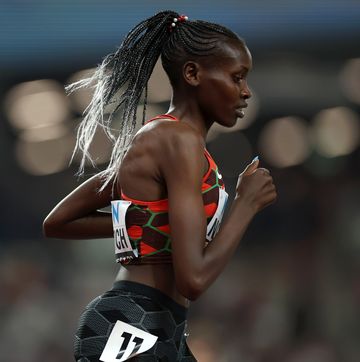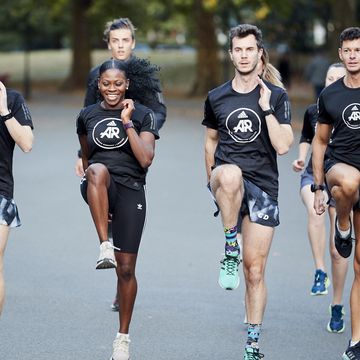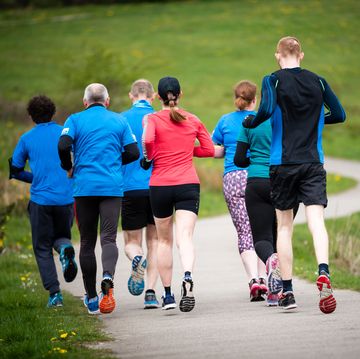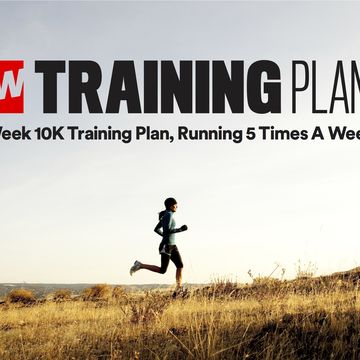There’s nothing like racing a fast 5K or 10K – they’re rewarding distances to race and they give you a great runner’s high. But to race fast, you’ve got to run fast in training, so runners seeking to maximise their 5K or 10K potential need to do some interval training.
Running at or faster than your goal race pace will make it feel easier over time and breaking it down into shorter chunks makes it feel more manageable. The sessions collected here are designed to help you improve specific aspects of 5K and 10K fitness – improving speed and turnover, honing pace sense and discipline, boosting mental toughness and confidence, and helping you to develop a finishing kick.
Even those who are not preparing for a race can benefit from these workouts. As well as increasing anaerobic-threshold levels, interval training increases endurance and builds muscle strength. Typical steady-state distance running exercises the leg muscles in a certain range of motion, with the focus on slow-twitch fibres. By running at faster speeds, you exercise all your leg muscles and improve your flexibility during running.
After one or two months of steady distance running, do interval training once a week to reach optimal racing fitness, in addition to a weekly tempo and long run. Bookend these workouts with easy runs or cross-training on the days either side to help recovery and avoid overtaxing your body.
A running track is an ideal place to do them, as the surface is good and measuring the reps is easy. But if you don’t have one near you, any stretch of flat, traffic-free ground (measured using your GPS device or online mapping) will work just fine.
1. 1.5M progressor
Why: In this 10K-specific session, you hold back for the first repeat and then progressively get faster, which helps you learn to fight the tendency to go out too hard.
How: After a 10-min jog and 4 x 50m accelerations, run three 1.5-mile repeats. Run the first repeat slightly slower than 10K goal pace, the second at goal pace and the third slightly faster than goal pace. Recover between each with a three-min slow jog. Cool down for 10 minutes.
2. 5K fitness boost
Why: This is a hard session, but it acclimatises the body to running at 5K pace.
How: Warm up for 10 minutes. Do 4 x 700m, with a two-minute recovery jog between each. Start off at 5K pace, but go faster for the last 300m of each rep, and do each 700m rep slightly faster than the last. Recover with a slow five-minute jog. Then do 3 x 200m all out, with one-minute recoveries. Finally, cool down for 10 minutes.
3. Alternators
Why: A hard workout that will let you know you are race-ready. Upping the pace forces you to run faster on tiring legs – good race-day practice.
How: Run 800m hard, jog 200m, run 300m hard, jog 300m; repeat four to six times. Start the 800s at 10K goal pace and the 300s at 5K goal pace, and get slightly faster with each effort. This workout can be done throughout training: hit the maximum number of reps a month before your event.
4. Cut-down laps
Why: Helps you practise your 5K and 10K race pace, three laps at a time. The goal is to rehearse different race paces and to finish feeling spent.
How: After a 15-min warm-up that ends in four 15-second accelerations, do 3 x 400m at 10K pace, with 200m recovery jogs; 3 x 400m at 5K pace, with the same recovery intervals; then 3 x 400m at your one-mile pace, with the same recoveries. Jog for 400m between sets. Warm down for 10-15 mins.
5. Flying 500s
Why: Instils 10K race pace. ‘This is a great workout for targeting an upcoming 10K or building strength for a 5K,’ says Chris Derrick, winner of the Great Edinburgh International Cross Country in 2014 and 2015.
How: After a 10-15-minute warm-up, run 10 x 500m, with two-minute recoveries. Begin at slightly slower than your 10K race pace; gradually speed up so that your last repeat is slightly faster than your 10K race pace.
6. Gear changer
Why: Teaches you to accelerate when you’re tired, thus developing your ability to deliver a sustained kick. Do one of these four and two weeks out from a goal race.
How: Run 4 x 800m, with three to four minutes of rest between the efforts. Start each repeat at 5K pace in the first one, accelerate after 700m and go all out to the finish. In the second effort, accelerate after 600m; in the third, after 500m; in the final repeat, go as hard as you can after 400m.
7. 600 solution
Why: Build speed for 5K and 10K. ‘Lots of runners do 400m repeats, but psychologically it helps to do another 200m,’ says Janet Cherobon-Bawcom, who represented the US in the 10,000m at the 2012 Olympics.
How: Warm up for 15 minutes, including four or five 50m accelerations. If you’re targeting a 5K, run six 600m repeats at under 5K goal pace. If you’re aiming for a 10K, run eight to 10 repeats at 5K goal pace. Jog for two mins to recover between efforts.
8. 5K sharpener
Why: The longer reps get you used to the demands of race pace; the fast, short reps will improve your leg turnover when you’re tired.
How: Run 1,600m, 1,200m, 1,000m and 800m repeats, with 3:30 recoveries between them, and five mins recovery at the end of the set. Then run 2 x 300m and 2 x 200m, with 1:30 recoveries between them. Begin both sets a few secs per mile slower than race pace, but gradually speed up as the reps get shorter until you’re at, or above, race pace.
9. 5K/10K tune-up
Why: Mixing speed and tempo running prepares you for a fast 5K or 10K. Do this four weeks before your race.
How: After a warm-up, do 3 x 800m, with two-min recoveries between them and three mins’ recovery at the end of the set. Then do 3 x 400m, with 90-sec recoveries between them and five mins’ recovery at the end of the set. Do both sets at goal 5K pace or quicker. Then do 10 mins at tempo pace. Rest for five mins, then do 4 x 200m fast (not all out), with 60-sec recoveries.
10. 10K simulation
Why: Helps develop a strong finish. ‘I call it a simulation: it mirrors the 10K, while emphasising running hard when you’re tired,’ says Linda Somers Smith, a former Chicago Marathon champion.
How: Warm up for 10 minutes, including four or five 50m accelerations. Then run 2 x 800m at 5K pace, jogging for 400m to recover after each. Follow that with a four-mile run at a pace slightly slower than your half-marathon pace. Then finish with 2 x 800m at 5K pace. Cool down.












